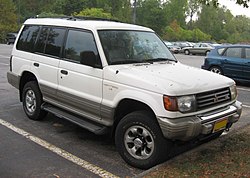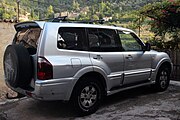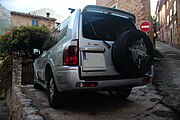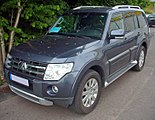Mitsubishi Pajero
| Mitsubishi Pajero | |
|---|---|
| Production period: | since 1982 |
| Class : | Off-road vehicle |
| Body versions : | Station wagon , convertible |
The Mitsubishi Pajero is an off-road vehicle from the Japanese automaker Mitsubishi Motors , which has been in production since spring 1982. From the beginning of 1983 it was also available worldwide. Since then, the car has been built in four generations.
Its name was borrowed from the Leopardus colocolo pajeros , who lives in the impassable mountain ranges of South America. The Pajero gained public fame through its numerous successes in the toughest motorsport rally in the world, the Paris-Dakar rally .
In Spanish-speaking countries as well as in North America, the pajero is called Montero because the Spanish word pajero means " wanker " in the vulgar language . In the UK the model is called the Shogun .
The first generation had the same chassis as the L200 pickup and the L300 minibus and was later reissued by Hyundai as the Hyundai Galloper with a slight facelift .
Mitsubishi and Chrysler were already working together in the 1980s . In America the Pajero was also available from Dodge and was then called the Dodge Raider .
Statistics show that 91% of buyers order the Pajero with a tow bar.
Pajero (L040, 1982-1990)
| 1st generation | |
|---|---|
|
Mitsubishi Pajero three-door (1982–1990) |
|
| Production period: | 1982-1990 |
| Body versions : | Station wagon , convertible |
| Engines: |
Otto engines : 2.6–3.0 liters (76–104 kW) Diesel engines : 2.3–2.5 liters (62–70 kW) |
| Length: | 3995-4650 mm |
| Width: | 1679 mm |
| Height: | 1849-1890 mm |
| Wheelbase : | 2350-2695 mm |
| Empty weight : | 1510-1935 kg |
The first Pajero came onto the European market at the beginning of 1983, while in Japan it was introduced about six months earlier.
It was equipped with a selectable all-wheel drive as standard. There is also an off-road reduction and a differential lock for an extra charge. The front wheels are individually suspended on double wishbones, at the rear on a rigid axle with semi-elliptical leaf springs. The Pajero is the first off-road vehicle to be equipped with internally ventilated disc brakes at the front.
For outdoor enthusiasts, the short version of the Pajero was also offered openly under the name Canvas-Top at the same retail price as the closed version. The original rag roof with three plastic windows has a variety of opening options . So you can roll up both sides and the rear window independently. Some manufacturers also offered hardtops in various designs. The Pajero was successfully used in the Dakar Rally .
Today the vehicles of the first generation have almost completely disappeared from the streets, especially because of rust problems.
- Engines
The Pajero was offered with the following engines:
- 2600, in in-line four-cylinder with 2555 cm³ displacement and 76 kW / 103 PS (04.1982–11.1990)
- 3000 V6, V-six-cylinder with 2972 cm³ displacement 104 kW / 141 PS (11.1988–11.1990)
- 2300 TD, in-line four-cylinder turbodiesel with 2346 cm³ displacement 62 kW / 84 PS (12.1982-04.1986)
- 2500 TD, in-line four-cylinder turbodiesel with 2477 cm³ displacement and 62 kW / 84 PS (05.1986-10.1989)
- 2500 TD, in-line four-cylinder turbodiesel with 2477 cm³ displacement and 70 kW / 95 PS (11.1988–11.1990)
Pajero (V20, 1990-2000)
| 2nd generation | |
|---|---|
|
Mitsubishi Pajero five-door (1990-1994) |
|
| Production period: | 1990-2000 |
| Body versions : | Station wagon , convertible |
| Engines: |
Otto engines : 2.4–3.5 liters (82–153 kW) Diesel engines : 2.5–2.8 liters (73–92 kW) |
| Length: | 4075-4704 mm |
| Width: | 1695 mm |
| Height: | 1875 mm |
| Wheelbase : | 2420-2725 mm |
| Empty weight : | 1530-2180 kg |
Deliveries of the second generation of Pajero began at the end of 1990. There were also three body variants of it: as a three-door, five-door and as a three-door convertible.
The highlight of the V20 was the flexible Super-Select-4-WD drive . This switchable all-wheel drive (based on rear-wheel drive) with off-road reduction (1.9: 1) has a central differential with viscous brake, which can also be locked 100%. A rear differential lock was also available as an option.
In mid-1994 the Pajero was slightly revised. The indicators at the front now merged into the main headlights and were now colored white. Modified lights were also installed at the rear.
Pajero Dakar
In the course of the facelift, Mitsubishi also offered some special models of the Pajero. The limited edition Dakar, which is limited to 50 pieces, is now a sought-after collector's item. Based on the 3-door Pajero, the company GeCo-Raid Sport under the direction of Sven Quandt converted these 50 vehicles. Distinguishing features include the Recaro sports seats in Avus Imola design, the stainless steel side bars and the stainless steel front bar. In addition, all Dakar have a sticker below the air conditioning on which the number of the corresponding model is indicated.
Pajero Classic
Conceived as an inexpensive alternative to the Pajero V60 introduced in spring 2000, Mitsubishi brought its predecessor V20 back onto the market as Pajero Classic in summer 2002.
The vehicle was still available as a three- and five-door model; the entry-level price of 25,950 euros for the three-door and 29,990 euros for the five-door was significantly lower than that of the V60.
The only engine variant was a 2.5-liter four-cylinder turbodiesel with 85 kW / 115 PS, low in emissions in accordance with Euro 3. In contrast to the original V20 series, the Classic was only produced with selectable all-wheel drive, the Super Select all-wheel drive is not available.
Engines
Otto
| model | Engine type | Cylinders / valves | Displacement | Power [kW / PS] | Torque [Nm] | construction time | comment |
|---|---|---|---|---|---|---|---|
| 1.8 GDi | 4G93 | 4/16 | 1834 cc | 96/131 | 174 | 06.1998-04.2000 | only as a convertible |
| 2400 | 4G64 | 4/8 | 2351 cc | 82/112 | 184 | 04.1991-04.2000 | |
| 3000 V6 | 6G72 | 6/12 | 2972 cc | 110/150 | 236 | 12.1990-12.1995 | |
| 3.0 V6 | 6G72 | 6/12 | 2972 cc | 130/177 | 255 | 06.1997-04.2000 | only as convertible and American Dream (1997) |
| 3000 V6 | 6G72 | 6/24 | 2972 cc | 133/181 | 255 | 06.1994-04.2000 | |
| 3500 V6 | 6G74 | 6/24 | 3497 cc | 153/208 | 300 | 06.1994-06.1997 | DOHC |
| 3500 V6 | 6G74 | 6/24 | 3497 cc | 143/194 | 313 | 07.1997-10.1999 | SOHC |
diesel
| model | Engine type | Cylinders / valves | Displacement | Power [kW / PS] | Torque [Nm] | construction time |
|---|---|---|---|---|---|---|
| 2500 TD | 4D56 | 4/8 | 2477 cm³ / toothed belt | 73/99 | 240 | 12.1990-04.2000 |
| 2800 TD | 4M40 | 4/8 | 2835 cc / chain | 92/125 | 292 | 06.1994-10.1999 |
Pajero (V60, 2000-2006)
| 3rd generation | |
|---|---|
|
Mitsubishi Pajero (2000-2003) |
|
| Production period: | 2000-2006 |
| Body versions : | Station wagon , convertible |
| Engines: |
Otto engine : 3.5 liters (149 kW) Diesel engines : 3.2 liters (118–121 kW) |
| Length: | 4798 mm |
| Width: | 1877 mm |
| Height: | 1857 mm |
| Wheelbase : | 2545-2780 mm |
| Empty weight : | 2130 kg |
The third generation of the Pajero came onto the German market in April 2000.
In contrast to its predecessor, the Pajero V60 was equipped with independent suspension on the front and rear axles and was only available with the all-wheel drive Super Select 4WD II. The recirculating ball was replaced with a rack and pinion steering.
In autumn 2001, the diesel engine was revised due to changed emissions regulations, which led to a power loss of three kW.
In mid-2003 Mitsubishi gave the Pajero a facelift, which was recognizable by the round instead of square fog lights.
Engines
Otto
| model | Engine type | cylinder | Displacement | Power [kW / PS] | Torque [Nm] | construction time |
|---|---|---|---|---|---|---|
| 3.5 V6 GDI | 6G74 | V6 | 3497 cc | 149/203 at 5000 rpm | 318 at 4000 rpm | 01.2000–12.2006 |
diesel
| model | Engine type | cylinder | Displacement | Power [kW / PS] | Torque [Nm] | construction time |
|---|---|---|---|---|---|---|
| 3.2 DI-D | 4M41 | R4 | 3200 cc | 121/165 at 3800 rpm | 373 at 2000 rpm | 01.2000–05.2003 |
| 3.2 DI-D | 4M41 | R4 | 3200 cc | 118/160 at 3800 rpm | 373 at 2000 rpm | 06.2003–12.2006 |
Pajero Classic
In May 2005 Mitsubishi replaced the Pajero Classic V20 with a model of the same name based on the V60. The prices started at 29,990 euros for the three-door and 34,990 euros for the five-door (price of the standard five-door: 43,300 euros, as of February 2006).
The Classic differs optically from the regular model in that it has unpainted front and rear aprons and steel rims. It was only available with a manual five-speed gearbox. The 3.2-l-DI-D with 118 kW / 160 PS, known from the regular V60, was available as a motor. In contrast to the previous model, the V60 Classic has the same Super Select all-wheel drive as the regular model.
Pajero (V80, V90, since 2007)
| 4th generation | |
|---|---|
|
Mitsubishi Pajero three-door (since 2015) |
|
| Production period: | since 2007 |
| Body versions : | Station wagon , convertible |
| Engines: |
Otto engines : 3.0–3.8 liters (128–184 kW) Diesel engines : 3.2 liters (118–147 kW) |
| Length: | 4385-4900 mm |
| Width: | 1875 mm |
| Height: | 1860-1890 mm |
| Wheelbase : | 2545-2780 mm |
| Empty weight : | 2110-2493 kg |
The last Pajero, which has been on the market since February 2007 as a three-door model with a short wheelbase or a five-door model with a long wheelbase, has been technically improved and only slightly changed in appearance.
The engines have been revised. The diesel was equipped with common rail injection (118 kW for manual transmission and 125 kW for automatic transmission); In addition, the diesels now have a particle filter on board as standard . The 3.5-liter V6 GDI gasoline engine from the previous model was swapped for the 3.8-liter MPI gasoline engine (known from the Endeavor and Eclipse). The engine output rose from 149 to 182 kW for the three-door and 184 kW for the five-door.
Combined, the standard consumption starts at 9.2 liters (three-door, CO 2 emissions from 244 g / km) or 9.3 liters (five-door, CO 2 emissions from 246 g / km).
In January 2009, the 3.2 DI-D engine was revised and from now on has an output of 147 kW / 200 PS and a maximum torque of 441 Nm. In addition, the standard consumption fell to 7.8 [8.2] liters (three-door, manual transmission [automatic]) and 7.9 [8.3] liters (five-door). This results in CO 2 emissions of 207 [216] g / km or 209 [221] g / km. The short version now meets the Euro 5 emissions standard . The V6 petrol engine was no longer offered in Germany from this point in time.
In July 2012 the Pajero got a slight facelift. The front was modernized with a new bumper and a revised radiator grille. In 2018, the sale of the Pajero in Europe was stopped. Sales also ended in Japan in August 2019. The vehicle is still offered in some markets.
Engines
Motors that are no longer available have a dark background.
Otto
| model | Engine type | Cylinders / valves | Displacement | Power [kW / PS] | Torque [Nm] | transmission | construction time |
|---|---|---|---|---|---|---|---|
| 3.0 V6 (five-door) | 6G72 | V6 / 24 | 2972 cc | 128/174 at 5250 rpm | 255 at 4000 rpm | Automatic | since 2009 |
| 3.8 V6 (three-door) | 6G75 | V6 / 24 | 3828 cc | 182/248 at 6000 rpm | 329 at 2750 rpm | Automatic | 01.2007–01.2010 |
| 3.8 V6 (five-door) | 6G75 | V6 / 24 | 3828 cc | 184/250 at 6000 rpm | 329 at 2750 rpm | Automatic | 01.2007–01.2010 |
The 3.0-liter gasoline engine offered in Russia and China since 2009 has the following data:
| model | Five-door |
|---|---|
| Construction period | since 2009 |
| cylinder | 6th |
| Displacement (cm³) | 2972 |
| Max. Power (kW / PS) | 128/174 at 5250 rpm |
| Max. Torque (Nm) | 255 at 4000 rpm |
| Top speed (km / h) | 175 |
| Transmission (standard) | 5-speed automatic transmission |
| Acceleration (0-100 km / h) | 13.6 s |
| Combined consumption (l / 100 km) | 12.7 p |
| Tank capacity | 88 |
diesel
| model | Engine type | Cylinders / valves | Displacement | Power [kW / PS] | Torque [Nm] | transmission | construction time |
|---|---|---|---|---|---|---|---|
| 3.2 DI-D | 4M41 | R4 / 16 | 3200 cc | 118/160 at 3800 rpm | 381 at 2000 rpm | Manual transmission | 01.2007–01.2009 |
| 3.2 DI-D | 4M41 | R4 / 16 | 3200 cc | 125/170 at 3800 rpm | 373 at 2000 rpm | Automatic | 01.2007–01.2009 |
| 3.2 DI-D | 4M41 | R4 / 16 | 3200 cc | 147/200 at 3800 rpm | 441 at 2000 rpm | Manual / automatic | 01.2009-08.2015 |
| 3.2 DI-D | 4M41 | R4 / 16 | 3200 cc | 140/190 at 3500 rpm | 441 at 2000 rpm | Automatic | 09.2015-08.2015 |
The 3.2 DI-D diesel engine offered from the beginning of 2009 has the following data:
| model | Three-door | Five-door | ||||
|---|---|---|---|---|---|---|
| Construction period | 01.2009-08.2015 | 09.2015-08.2018 | 01.2009-08.2015 | 09.2015-08.2018 | ||
| version | Manual transmission | Automatic | Manual transmission | Automatic | ||
| cylinder | 4th | |||||
| Displacement (cm³) | 3200 | |||||
| Max. Power (kW / PS) | 147/200 at 3800 rpm | 140/190 at 3500 rpm | 147/200 at 3800 rpm | 140/190 at 3500 rpm | ||
| Max. Torque (Nm) | 441 at 2000 rpm | |||||
| Top speed (km / h) | 180 | |||||
| Transmission (standard) | 5-speed manual transmission | 5-speed automatic transmission | 5-speed manual transmission | 5-speed automatic transmission | ||
| Acceleration (0-100 km / h) | 9.7 s | 10.4 s | 10.5 s | 11.1 s | ||
| Combined consumption (l / 100 km) | 9.5 D | 10.0D | 9.0 D. | 9.6 D | 10.1 D | 9.3 D |
| Tank capacity | 69 | 88 | ||||
| Emission standard | 5 EURO | EURO 6 | 5 EURO | EURO 6 | ||
Body styles
The Pajero is offered as a three- and five-door model. The variants do not differ in terms of equipment features, only the dimensions are different.
| model | Three-door | Five-door |
|---|---|---|
| Total length (mm) | 4385 | 4900 |
| Total width (mm) | 1875 | 1875 |
| Total height (mm) | 1840 * / 1870 ** | 1860 * / 1890 ** |
| Wheelbase (mm) | 2545 | 2780 |
| Empty weight kg) | 2213-2273 | 2408-2493 |
| Max. Load (kg) | 392-452 | 537-622 |
| Trailer load braked (kg) | 2800-3000 | 3300-3500 |
* Only the lowest equipment line; ** Only the highest equipment line
Individual evidence
- ↑ Holger Wittich: When car names go wrong. auto-motor-und-sport.de, March 21, 2013.
- ↑ Jürgen Pander: Mitsubishi Pajero Driving Report - One to Steal Horses , spiegel.de from August 4, 2017, accessed on August 17, 2019
- ↑ Didi Hubmann: In the test: The Mitsubishi Pajero says goodbye to the restart. In: kleinezeitung.at. October 22, 2018. Retrieved December 29, 2018 .
- ^ Danny Tan: Mitsubishi Pajero Final Edition - a 700-unit farewell. In: paultan.org. April 26, 2019, accessed December 26, 2019 .


















